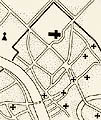![]() York
York
 As
the largest and most important city in northern England, York played a crucial
role in the determining the country's fate in the years 1066-9. It was first
captured by Harald Hardrada after the battle of Fulford, but then retaken
by Harold of England after the battle of Stamford Bridge. After Harold's defeat
at Hastings York was seized by the Normans in 1068 when a motte and bailey
castle was built on the north-east bank of the River Ouse. Early in 1069,
after a serious northern revolt, William built a second castle on the opposite
bank of the Ouse. In September 1069 he returned to crush a further rising
and is thought to have burnt part of the city. The Normans then tightened
their grip on York by refurbishing the city defences with a great ditch and
earthen rampart.
As
the largest and most important city in northern England, York played a crucial
role in the determining the country's fate in the years 1066-9. It was first
captured by Harald Hardrada after the battle of Fulford, but then retaken
by Harold of England after the battle of Stamford Bridge. After Harold's defeat
at Hastings York was seized by the Normans in 1068 when a motte and bailey
castle was built on the north-east bank of the River Ouse. Early in 1069,
after a serious northern revolt, William built a second castle on the opposite
bank of the Ouse. In September 1069 he returned to crush a further rising
and is thought to have burnt part of the city. The Normans then tightened
their grip on York by refurbishing the city defences with a great ditch and
earthen rampart.

 In
about 1080, Archbishop Thomas of Bayeux began to rebuild the Minster in Romanesque
style. Another large Romanesque church was erected as part of St Mary's Abbey,
founded in the 1080s immediately north-west of the city defences, which became
the largest and most influential Benedictine monastery in the north. Close
by, but within the walls, was St Leonard's Hospital, the largest institution
caring for the sick and infirm in the region. The parish churches of the pre-Conquest
city were rebuilt in the Norman period and many new ones were founded.
In
about 1080, Archbishop Thomas of Bayeux began to rebuild the Minster in Romanesque
style. Another large Romanesque church was erected as part of St Mary's Abbey,
founded in the 1080s immediately north-west of the city defences, which became
the largest and most influential Benedictine monastery in the north. Close
by, but within the walls, was St Leonard's Hospital, the largest institution
caring for the sick and infirm in the region. The parish churches of the pre-Conquest
city were rebuilt in the Norman period and many new ones were founded.
 Although
houses in one of its 'seven shires' had been cleared away for the castles,
Domesday Book suggests that in 1086 York had a population of about 10,000.
Archaeological excavations have shown how the city grew rapidly under the
Norman kings expanding into new suburbs outside the defences. One of these,
in the Walmgate area to the south-east, was included within the defences in
the 12th century. Prosperity was based on manufacturing, especially of woollen
textiles, and on trade both local and international. Dated to about 1125 there
is a documentary reference to boats arriving from Ireland and Germany. By
1130 prosperous and influential townsfolk had formed a merchant guild with
its own meeting house.
Although
houses in one of its 'seven shires' had been cleared away for the castles,
Domesday Book suggests that in 1086 York had a population of about 10,000.
Archaeological excavations have shown how the city grew rapidly under the
Norman kings expanding into new suburbs outside the defences. One of these,
in the Walmgate area to the south-east, was included within the defences in
the 12th century. Prosperity was based on manufacturing, especially of woollen
textiles, and on trade both local and international. Dated to about 1125 there
is a documentary reference to boats arriving from Ireland and Germany. By
1130 prosperous and influential townsfolk had formed a merchant guild with
its own meeting house.